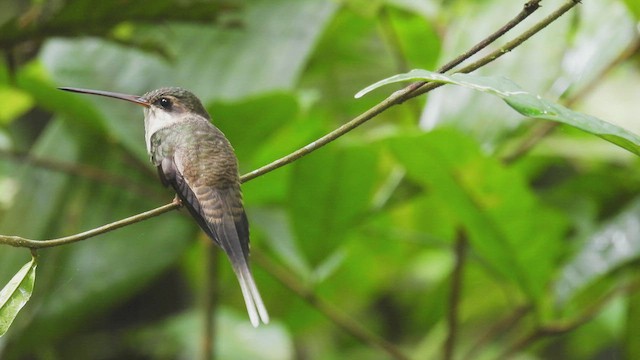Straight-billed Hermit Phaethornis bourcieri Scientific name definitions
Text last updated February 10, 2013
Sign in to see your badges
Species names in all available languages
| Language | Common name |
|---|---|
| Bulgarian | Сиво слънчево колибри |
| Catalan | colibrí ermità de Bourcier |
| Croatian | maslinastoleđi kolibrić |
| Czech | kolibřík šídlozobý |
| Dutch | Priemsnavelheremietkolibrie |
| English | Straight-billed Hermit |
| English (United States) | Straight-billed Hermit |
| Estonian | amasoonia selvakoolibri |
| Finnish | kalpaerakkokolibri |
| French | Ermite de Bourcier |
| French (Canada) | Ermite de Bourcier |
| German | Braunbauch-Schattenkolibri |
| Japanese | ケンハシハチドリ |
| Norwegian | floretteremitt |
| Polish | pustelnik prostodzioby |
| Portuguese (Brazil) | rabo-branco-de-bico-reto/barriga-cinza |
| Portuguese (Portugal) | Rabo-branco-de-bico-direito |
| Russian | Прямоклювый колибри-отшельник |
| Serbian | Pravokljuni kolibri pustinjak |
| Slovak | slnečníček priamozobý |
| Spanish | Ermitaño Piquirrecto |
| Spanish (Ecuador) | Ermitaño Piquirrecto |
| Spanish (Peru) | Ermitaño de Pico Recto |
| Spanish (Spain) | Ermitaño piquirrecto |
| Spanish (Venezuela) | Ermitaño Picorrecto |
| Swedish | floretteremit |
| Turkish | Düz Gagalı Hermit |
| Ukrainian | Ерміт прямодзьобий |
Phaethornis bourcieri (Lesson, 1832)
Definitions
- PHAETHORNIS
- bourcieri
The Key to Scientific Names
Legend Overview
Introduction
Frequently on the go, the Straight-billed Hermit flies quickly along the understory foraging at flowers. While it resembles other large hermits, the Straight-billed Hummingbird is fairly drab and very appropriately named with its identifiable, straight bill. Males have small singing territories where they wiggle their tails as they sing. These hermits are considered common throughout their range.
Field Identification
12–14 cm (1); 3·5–5 g (1). Medium-sized hermit with olive-green upperparts and brownish (“whitelyi coloration”) to greyish (“bourcieri coloration”) underparts ; straight bill . Female has shorter wings and bill; almost no curvature visible in bill. Juvenile has pale ochraceous edging to feathers of upperparts. Race major significantly larger in all measurements, with plumage coloration similar to nominate form with greyish underparts.
Systematics History
Editor's Note: This article requires further editing work to merge existing content into the appropriate Subspecies sections. Please bear with us while this update takes place.
In the past was sometimes placed in genus Ametrornis. Morphological characters argue against close relationship to other hermits with straight bill, P. philippii and P. koepckeae. Many authors have accepted additional race whitelyi for N birds, but claimed characters correspond to individual variation, both types of coloration occurring throughout range of nominate race. Two subspecies recognized.Subspecies
Straight-billed Hermit (bourcieri) Phaethornis bourcieri bourcieri Scientific name definitions
Distribution
SE Colombia, E Ecuador and NE Peru E to S Venezuela, the Guianas and Brazil N and S of Amazon, including presumably much of Amazonas and Acre states (2).
Phaethornis bourcieri bourcieri (Lesson, 1832)
Definitions
- PHAETHORNIS
- bourcieri
The Key to Scientific Names
Legend Overview
Straight-billed Hermit (major) Phaethornis bourcieri major Scientific name definitions
Distribution
Phaethornis bourcieri major Hinkelmann, 1989
Definitions
- PHAETHORNIS
- bourcieri
- major
The Key to Scientific Names
Legend Overview
Distribution
Editor's Note: Additional distribution information for this taxon can be found in the 'Subspecies' article above. In the future we will develop a range-wide distribution article.
Habitat
Understorey of lowland terra firme rainforest, and dense areas of adjacent semi-deciduous or pre-montane forest, up to 1600 m in S Venezuelan mountains; occasionally at forest edge, in bamboo thickets, dense shrubbery, várzea forest, second growth or plantations.
Movement
Diet and Foraging
Nectar and small arthropods. Recorded at flowers of Manettia, Guzmania and Vriesea; feeds by trap-lining.
Sounds and Vocal Behavior
Song quite different compared to most large Phaethornis: a high-pitched phrase repeated over and over, punctuated by short dull-sounding notes, “tsii’ti’ti’tsii...tip...tip...tsii’ti’ti’tsii....tip...tip...tip...”. Calls inclue a rather monotonous “tseet” and a dull “chep”, usually given in flight.
Breeding
Mar–May in Brazil; active nests Sept in Manaus and Amapá, Brazil, Oct in French Guiana, Sept in Colombia; gonadal activity Sept in Colombia, and Jul, Aug, Oct, Nov in Peru. Nest is long, cone-shaped cup of plant matter and cobweb fastened under tip of long, hanging leaf; height 52 mm, external diameter 50 mm and internal diameter 20 mm (1). Two white eggs, size 8·5 mm × 13 mm (1); incubation 17–18 days, by female; fledging c. 23 days. At hatching, chick has eyes closed and down scattered over body.
Conservation Status
Not globally threatened (Least Concern). CITES II. Common throughout its range, which has recently been demonstrated to extend well S of the Amazon to Acre (2). Regularly seen in primary forest at the Voltzberg Nature Reserve, Suriname, with local population density of at least 2–3 pairs/km². Occurs in several protected areas, e.g. Amacayacu National Park (Colombia) and Imataca Forest Reserve (Venezuela).

- Year-round
- Migration
- Breeding
- Non-Breeding

















































